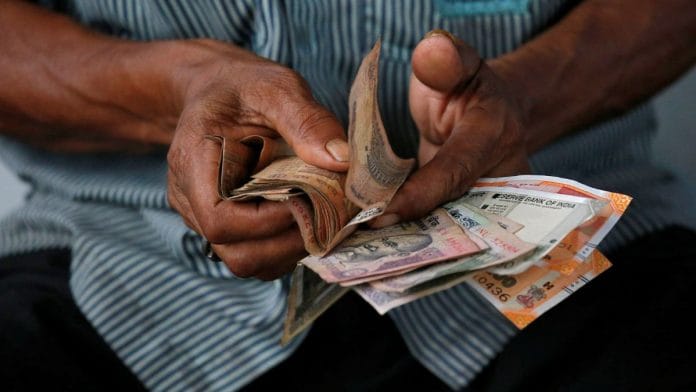Many are of the view that state government debt is not a problem in India. Sure, borrowings are higher than a few years ago, but the bond market is still lending to governments, there is no upheaval in credit ratings, the spread between the Government of India bonds and state government bonds is not large, and the debt to GSDP ratios are not very high. The Union government can always print money, and we don’t have much exposure to international creditors. The problem, however, is that there may be more stress in the fisc of state governments than is visible in the standard metrics. While there may not be a “default” in the traditional sense of the term, there are consequences for the developmental strategy of the state.
Also read: India’s fifth-largest economy rank is pointless. States’ population eats into gains
Hidden numbers
Take the case of Tamil Nadu. As of FY22, interest payments were 20 per cent of revenue receipts, debt outstanding was 26 per cent of GSDP, and the gross fiscal deficit was 4 per cent of GSDP. These are not scary numbers. But they may not provide the full picture for the following reasons.
First, overall debt does not capture the guarantees the state government has provided on loans taken by other public sector entities in the state. If a loan by a state enterprise goes bad, and the government has guaranteed it, then the repayment of that loan will fall on the state government. Outstanding guarantees in Tamil Nadu increased by 39 per cent between FY20 and FY21. If one were to include guarantees in the debt, then the debt to GSDP ratio would rise to 31 per cent from 26 per cent.
Second, several state governments have off-budget borrowings that do not show on the balance sheets. This implies that the overall debt to GSDP ratio may be higher than what is reflected in the books. Third, many state enterprises have taken on debt that is technically not guaranteed by the government. But if the entity—for example, the electricity distribution utility—were to default, then it is difficult to imagine the state government not coming to their rescue. Staying with the Tamil Nadu example, the total outstanding borrowings of the Tamil Nadu Generation and Distribution Corporation (TANGEDCO) were over Rs 1,45,000 crore in FY22. While this isn’t reflected in the state debt, the possibility of default must play on the state’s mind.
Also Read: Glittering GDP, high poverty: The paradox of Karnataka’s unequal growth
Who is lending to the state?
If there are simmering problems in the financials of a state, how is the state still able to borrow without much repercussions? Why don’t lenders seem to reward the fiscally conservative states and punish the profligate ones? The Indian bond market does not price the credit risk of the state. There is an expectation of a sovereign guarantee—if the state government is not able to pay, the Union will provide support. As a consequence, the probability of default by any state is considered to be close to zero. The bond market is also captive as institutions are mandated to purchase government bonds as part of their investment guidelines. The choice, therefore, is limited and the pricing does not accurately reflect the risk.
Understanding the implications of state borrowing is crucial, especially when considering the unique fiscal constraints of northeastern states that often rely heavily on external support and face significant debt burdens.
State enterprises are able to borrow from financial institutions such as the Power Finance Corporation in the form of loans. The financial institutions are often public sector entities that are funded by either the bond market or through other retail or institutional depositors. It is quite likely that a state financial institution may feel obliged to lend to a state enterprise despite the balance sheet status of the enterprise. Depositors seem to also believe that public sector entities will not default, due to the perception that they are guaranteed by either their respective state government or ultimately the Union.
Also Read: Does breaking up big states boost economy? Data doesn’t back up hype, says Indian study
Impact of a ‘default’
The nature of financial markets in India is such that a default in the traditional sense is unlikely. States will find ways of financing their deficit for a much longer period than they would have in an environment where the bond market is more independent. But as interest payments begin to capture a larger share of revenue receipts, there will be consequences on the developmental expenditure in the state. The revenue expenditure in Tamil Nadu has grown by 9.6 per cent annually over the last decade—but interest payments have grown by 14 per cent. This means that other expenditures, which might benefit citizens more directly, have reduced.
There are other indirect consequences in terms of delayed payments to the private sector—reneging on contracts and increased litigation to postpone inevitable payments which further damages invest-ability and growth prospects that may help the state out of the stressed fiscal situation. Tamil Nadu is just an illustration—there are states in India that will fare worse on these metrics.
If the fiscal situation were to get worse, states may find it difficult to pay salaries and pensions. In the early 2000s, Odisha and West Bengal had reneged on paying their employees and pensioners because they had run into trouble. At the time interest payments in these states were between 30-35 per cent of their revenue receipts, and the debt-GSDP ratios were between 30-40 per cent. While states in India may not be at this precipice yet, they may find themselves there soon in the absence of efforts at course correction.
Renuka Sane is research director at TrustBridge, which works on improving the rule of law for better economic outcomes for India. She tweets @resanering. Views are personal.
(Edited by Theres Sudeep)






